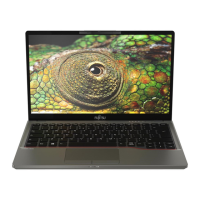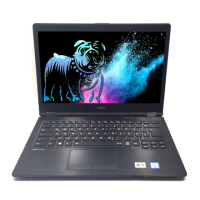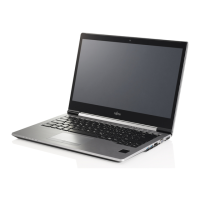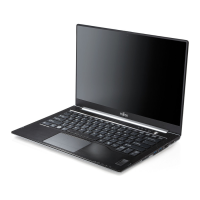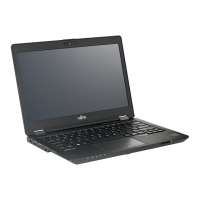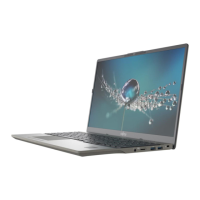Do you have a question about the Fujitsu LIFEBOOK U7311 and is the answer not in the manual?
Guides users to online resources for drivers, software, and updates.
Details the ports and indicators located on the front of the Fujitsu Lifebook.
Details the ports located on the left side of the Fujitsu Lifebook.
Details the ports located on the right side of the Fujitsu Lifebook.
Highlights critical safety precautions to observe when working with the notebook.
Provides specific safety guidelines for using wireless components like Wi-Fi and Bluetooth.
Offers tips on how to conserve battery power and extend operating time.
Explains how to use Windows power management features for energy efficiency.
Provides guidance on preparing for and traveling with the notebook safely.
Advises on how to protect the notebook during transport to prevent damage.
Details the correct procedures and precautions for cleaning the notebook.
Instructs on how to unpack and inspect the device for any transit damage.
Provides recommendations for choosing a suitable and safe environment for operating the notebook.
Explains the correct procedure for connecting the mains adapter to power the device.
Details the steps for powering on the notebook for the initial setup and software installation.
Explains the meaning of various status indicators on the notebook for power, hard disk, and keyboard.
Describes the process of powering on and shutting down the Fujitsu Lifebook notebook.
Details the functions and layout of the notebook's keyboard, including special keys.
Explains the virtual numeric keypad feature and its usage with the Fn key.
Lists and describes the functions of various F1-F12 keys and key combinations.
Explains the F-Lock setting to change the primary function of the F1-F12 keys.
Details how to adjust the keyboard's background lighting for visibility and battery saving.
Guides on changing country and keyboard layout settings according to the operating system.
Describes the operation of the touchpad and its buttons for cursor control and selection.
Discusses LCD screen resolution and pixel quality standards for the notebook display.
Explains the notebook's background lighting and how to adjust screen brightness.
Details how to use finger gestures like tapping, dragging, and zooming on the touchscreen.
Describes the functionality and use of the integrated webcam and optional infrared camera.
Explains how to activate/deactivate the ePrivacy filter for screen privacy.
Provides information on the notebook's rechargeable battery and its lifespan.
Guides on proper charging, maintenance, and storage of the notebook battery.
Provides step-by-step instructions for safely removing and installing the notebook battery.
Details the process of inserting a Nano-SIM card into the notebook's SIM card slot.
Discusses wireless components and their installation, emphasizing approved hardware.
Explains how to enable or disable wireless components, including flight mode.
Guides on configuring wireless LAN access with necessary credentials.
Explains how to connect to the internet using the LTE module and available accessories.
Details how to connect the notebook to a local area network using an Ethernet cable.
Introduces the port replicator for connecting peripheral devices to the notebook.
Illustrates and lists the various ports available on the Fujitsu Port Replicator.
Guides on how to dock the notebook to the port replicator for expanded connectivity.
Explains how to connect the power adapter to the port replicator for system operation.
Details how to power on the notebook using the port replicator's ON/OFF button.
Provides instructions on how to safely undock the notebook from the port replicator.
Details the setup and use of the fingerprint sensor for authentication.
Explains the setup and use of the palm vein sensor for biometric authentication.
Guides on how to use the Kensington Lock Cable to secure the notebook from theft.
Covers setting up supervisor and user passwords in the BIOS Setup Utility for enhanced security.
Explains supervisor and user passwords to prevent unauthorized access to BIOS settings.
Step-by-step guide to setting up supervisor and user passwords in the BIOS.
Instructions on how to modify or delete existing BIOS supervisor and user passwords.
Details how to enable password protection for booting the operating system.
Explains how to secure the hard disk with a password via the BIOS.
Describes the TPM feature and its role in system security.
Provides instructions for activating or deactivating the Trusted Platform Module in BIOS.
Introduces the SmartCard reader and its compatibility with various SmartCards.
Guides on the correct procedure for inserting a SmartCard into the reader.
Provides general safety guidelines and instructions for connecting external devices.
Explains how to connect analogue and digital monitors to the notebook or port replicator.
Details how to connect various USB devices, including data transfer rates.
Describes the USB Type-C port with charging and display capabilities.
Explains the USB port functionality for charging devices, even when the notebook is off.
Details the correct procedure for safely disconnecting USB devices to prevent data loss.
Explains how to connect headsets, headphones, or microphones to the notebook's audio port.
Provides warnings and guidance for component removal and installation by qualified technicians.
Guides on how to access and start the BIOS Setup Utility.
Explains how to navigate and use the BIOS Setup Utility interface.
Details the options for saving changes, discarding changes, and exiting the BIOS Setup Utility.
Explains the Erase Disk feature for securely deleting data from hard drives or SSDs.
Provides solutions for common problems and general tips for using the notebook.
Guides users on what to do if they encounter unresolved problems with their computer.
Instructions for reinstalling the operating system using a recovery CD/DVD.
Explains how to reset the system to its original state using Windows 10 recovery options.
Troubleshooting steps for issues with the notebook's date and time settings.
Addresses problems where only numerals are entered when typing characters.
Provides solutions for when the notebook's LCD screen does not display any image.
Offers advice on improving LCD screen visibility, such as adjusting brightness.
Troubleshooting steps for when an external monitor connected to the notebook is blank.
Provides solutions for issues where the external monitor displays an unstable or incorrect image.
Troubleshooting steps for when the notebook fails to power on.
Provides solutions for when the notebook unexpectedly stops functioning or freezes.
Troubleshooting steps for issues when the printer connected to the notebook is not printing.
Guides on resolving problems with wireless network connectivity.
Troubleshooting steps for when the SmartCard reader fails to detect the inserted card.
Advice for users who have forgotten their SmartCard PIN.
Advice for users who have lost their SmartCard.
Lists common error messages from BIOS Setup and provides their resolutions.
Details operating and transit temperature, humidity, and operating height specifications.
Provides the physical dimensions and weight of the notebook.
Specifies the permanently installed RAM and supported memory module types.
Details the specifications of the notebook's rechargeable battery, including voltage and capacity.
Lists the electrical specifications for the notebook's primary and secondary mains adapter.
Details the electrical specifications for the port replicator's mains adapter.
Guides on the proper disposal and recycling of the notebook and its components.
Mentions TCO certification and directs users to further documentation.
Refers to additional certifications found in a separate supplement.
Guides users to online resources for drivers, software, and updates.
Details the ports and indicators located on the front of the Fujitsu Lifebook.
Details the ports located on the left side of the Fujitsu Lifebook.
Details the ports located on the right side of the Fujitsu Lifebook.
Highlights critical safety precautions to observe when working with the notebook.
Provides specific safety guidelines for using wireless components like Wi-Fi and Bluetooth.
Offers tips on how to conserve battery power and extend operating time.
Explains how to use Windows power management features for energy efficiency.
Provides guidance on preparing for and traveling with the notebook safely.
Advises on how to protect the notebook during transport to prevent damage.
Details the correct procedures and precautions for cleaning the notebook.
Instructs on how to unpack and inspect the device for any transit damage.
Provides recommendations for choosing a suitable and safe environment for operating the notebook.
Explains the correct procedure for connecting the mains adapter to power the device.
Details the steps for powering on the notebook for the initial setup and software installation.
Explains the meaning of various status indicators on the notebook for power, hard disk, and keyboard.
Describes the process of powering on and shutting down the Fujitsu Lifebook notebook.
Details the functions and layout of the notebook's keyboard, including special keys.
Explains the virtual numeric keypad feature and its usage with the Fn key.
Lists and describes the functions of various F1-F12 keys and key combinations.
Explains the F-Lock setting to change the primary function of the F1-F12 keys.
Details how to adjust the keyboard's background lighting for visibility and battery saving.
Guides on changing country and keyboard layout settings according to the operating system.
Describes the operation of the touchpad and its buttons for cursor control and selection.
Discusses LCD screen resolution and pixel quality standards for the notebook display.
Explains the notebook's background lighting and how to adjust screen brightness.
Details how to use finger gestures like tapping, dragging, and zooming on the touchscreen.
Describes the functionality and use of the integrated webcam and optional infrared camera.
Explains how to activate/deactivate the ePrivacy filter for screen privacy.
Provides information on the notebook's rechargeable battery and its lifespan.
Guides on proper charging, maintenance, and storage of the notebook battery.
Provides step-by-step instructions for safely removing and installing the notebook battery.
Details the process of inserting a Nano-SIM card into the notebook's SIM card slot.
Discusses wireless components and their installation, emphasizing approved hardware.
Explains how to enable or disable wireless components, including flight mode.
Guides on configuring wireless LAN access with necessary credentials.
Explains how to connect to the internet using the LTE module and available accessories.
Details how to connect the notebook to a local area network using an Ethernet cable.
Introduces the port replicator for connecting peripheral devices to the notebook.
Illustrates and lists the various ports available on the Fujitsu Port Replicator.
Guides on how to dock the notebook to the port replicator for expanded connectivity.
Explains how to connect the power adapter to the port replicator for system operation.
Details how to power on the notebook using the port replicator's ON/OFF button.
Provides instructions on how to safely undock the notebook from the port replicator.
Details the setup and use of the fingerprint sensor for authentication.
Explains the setup and use of the palm vein sensor for biometric authentication.
Guides on how to use the Kensington Lock Cable to secure the notebook from theft.
Covers setting up supervisor and user passwords in the BIOS Setup Utility for enhanced security.
Explains supervisor and user passwords to prevent unauthorized access to BIOS settings.
Step-by-step guide to setting up supervisor and user passwords in the BIOS.
Instructions on how to modify or delete existing BIOS supervisor and user passwords.
Details how to enable password protection for booting the operating system.
Explains how to secure the hard disk with a password via the BIOS.
Describes the TPM feature and its role in system security.
Provides instructions for activating or deactivating the Trusted Platform Module in BIOS.
Introduces the SmartCard reader and its compatibility with various SmartCards.
Guides on the correct procedure for inserting a SmartCard into the reader.
Provides general safety guidelines and instructions for connecting external devices.
Explains how to connect analogue and digital monitors to the notebook or port replicator.
Details how to connect various USB devices, including data transfer rates.
Describes the USB Type-C port with charging and display capabilities.
Explains the USB port functionality for charging devices, even when the notebook is off.
Details the correct procedure for safely disconnecting USB devices to prevent data loss.
Explains how to connect headsets, headphones, or microphones to the notebook's audio port.
Provides warnings and guidance for component removal and installation by qualified technicians.
Guides on how to access and start the BIOS Setup Utility.
Explains how to navigate and use the BIOS Setup Utility interface.
Details the options for saving changes, discarding changes, and exiting the BIOS Setup Utility.
Explains the Erase Disk feature for securely deleting data from hard drives or SSDs.
Provides solutions for common problems and general tips for using the notebook.
Guides users on what to do if they encounter unresolved problems with their computer.
Instructions for reinstalling the operating system using a recovery CD/DVD.
Explains how to reset the system to its original state using Windows 10 recovery options.
Troubleshooting steps for issues with the notebook's date and time settings.
Addresses problems where only numerals are entered when typing characters.
Provides solutions for when the notebook's LCD screen does not display any image.
Offers advice on improving LCD screen visibility, such as adjusting brightness.
Troubleshooting steps for when an external monitor connected to the notebook is blank.
Provides solutions for issues where the external monitor displays an unstable or incorrect image.
Troubleshooting steps for when the notebook fails to power on.
Provides solutions for when the notebook unexpectedly stops functioning or freezes.
Troubleshooting steps for issues when the printer connected to the notebook is not printing.
Guides on resolving problems with wireless network connectivity.
Troubleshooting steps for when the SmartCard reader fails to detect the inserted card.
Advice for users who have forgotten their SmartCard PIN.
Advice for users who have lost their SmartCard.
Lists common error messages from BIOS Setup and provides their resolutions.
Details operating and transit temperature, humidity, and operating height specifications.
Provides the physical dimensions and weight of the notebook.
Specifies the permanently installed RAM and supported memory module types.
Details the specifications of the notebook's rechargeable battery, including voltage and capacity.
Lists the electrical specifications for the notebook's primary and secondary mains adapter.
Details the electrical specifications for the port replicator's mains adapter.
Guides on the proper disposal and recycling of the notebook and its components.
Mentions TCO certification and directs users to further documentation.
Refers to additional certifications found in a separate supplement.
| Graphics | Intel Iris Xe Graphics |
|---|---|
| Processor | Intel Core i5-1135G7 / i7-1165G7 |
| Display | 1920 x 1080 (Full HD) |
| RAM | 8GB / 16GB / 32GB DDR4 |
| Storage | 256GB / 512GB / 1TB SSD |
| Operating System | Windows 11 Pro |
| Ports | HDMI |
| Wireless | Wi-Fi 6, Bluetooth 5.1 |
| Security | Fingerprint sensor, TPM 2.0 |
